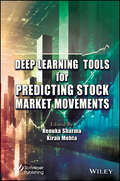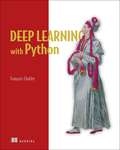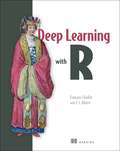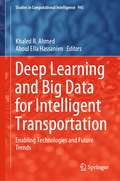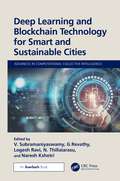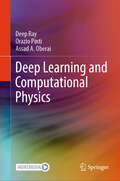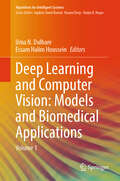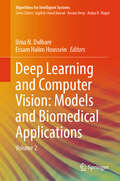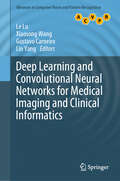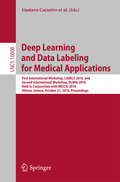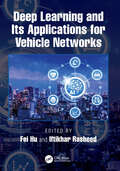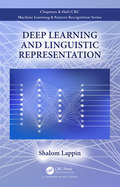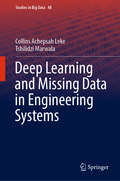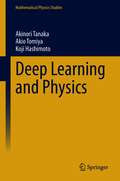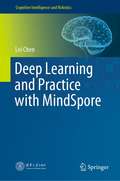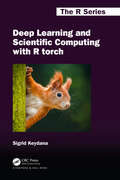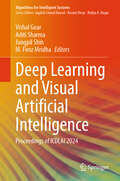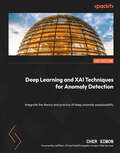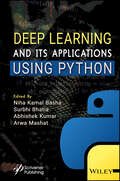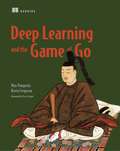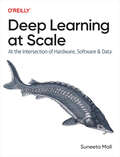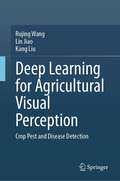- Table View
- List View
Deep Learning Tools for Predicting Stock Market Movements
by Renuka Sharma Kiran MehtaDEEP LEARNING TOOLS for PREDICTING STOCK MARKET MOVEMENTS The book provides a comprehensive overview of current research and developments in the field of deep learning models for stock market forecasting in the developed and developing worlds. The book delves into the realm of deep learning and embraces the challenges, opportunities, and transformation of stock market analysis. Deep learning helps foresee market trends with increased accuracy. With advancements in deep learning, new opportunities in styles, tools, and techniques evolve and embrace data-driven insights with theories and practical applications. Learn about designing, training, and applying predictive models with rigorous attention to detail. This book offers critical thinking skills and the cultivation of discerning approaches to market analysis. The book: details the development of an ensemble model for stock market prediction, combining long short-term memory and autoregressive integrated moving average; explains the rapid expansion of quantum computing technologies in financial systems; provides an overview of deep learning techniques for forecasting stock market trends and examines their effectiveness across different time frames and market conditions; explores applications and implications of various models for causality, volatility, and co-integration in stock markets, offering insights to investors and policymakers. Audience The book has a wide audience of researchers in financial technology, financial software engineering, artificial intelligence, professional market investors, investment institutions, and asset management companies.
Deep Learning With Python
by Francois CholletDeep Learning with Python introduces the field of deep learning using the Python language and the powerful Keras library. Written by Keras creator and Google AI researcher Francois Chollet, this book builds your understanding through intuitive explanations and practical examples.
Deep Learning With R
by François Chollet J. J. AllaireDeep Learning with R introduces the world of deep learning using the powerful Keras library and its R language interface. The book builds your understanding of deep learning through intuitive explanations and practical examples.
Deep Learning and Big Data for Intelligent Transportation: Enabling Technologies and Future Trends (Studies in Computational Intelligence #945)
by Aboul Ella Hassanien Khaled R. AhmedThis book contributes to the progress towards intelligent transportation. It emphasizes new data management and machine learning approaches such as big data, deep learning and reinforcement learning. Deep learning and big data are very energetic and vital research topics of today’s technology. Road sensors, UAVs, GPS, CCTV and incident reports are sources of massive amount of data which are crucial to make serious traffic decisions. Herewith this substantial volume and velocity of data, it is challenging to build reliable prediction models based on machine learning methods and traditional relational database. Therefore, this book includes recent research works on big data, deep convolution networks and IoT-based smart solutions to limit the vehicle’s speed in a particular region, to support autonomous safe driving and to detect animals on roads for mitigating animal-vehicle accidents. This book serves broad readers including researchers, academicians, students and working professional in vehicles manufacturing, health and transportation departments and networking companies.
Deep Learning and Blockchain Technology for Smart and Sustainable Cities (Advances in Computational Collective Intelligence)
by V. Subramaniyaswamy N. Thillaiarasu Naresh Kshetri G Revathy Logesh RaviIn this digital era, a smart city can become an intelligent society by using advances in emerging technologies. Specifically, the rapid adoption of deep learning (DL) in fusion with blockchain technology has led to a new digital smart city ecosystem. A broad spectrum of DL and blockchain applications promises solutions for problems in areas ranging from risk management and financial services to cryptocurrency to public and social services. Furthermore, the convergence of artificial intelligence and blockchain technology is revolutionizing the smart city network architecture to build sustainable ecosystems. However, these advances in technology bring both opportunities and challenges in creating sustainable smart cities.To help planners and developers to meet these challenges and exploit these opportunities, Deep Learning and Blockchain Technology for Smart and Sustainable Cities takes a deep dive into the technologies and applications that enable smart and sustainable cities. It provides a comprehensive literature review of the security issues and problems that impact the deployment of blockchain systems in smart cities. It presents a detailed discussion of key factors in the convergence of blockchain and DL technologies that help form sustainable smart societies. This book also discusses blockchain security enhancement solutions and summarizes main key points necessary for developing various blockchain and DL‑based intelligent transportation systems.This book concludes with a discussion of open issues and future research direction.These include new security suggestions and guidelines for a sustainable smart city ecosystem. Also discussed is 6G‑enabled DL and blockchain in real‑time applications.
Deep Learning and Computational Physics
by Deep Ray Orazio Pinti Assad A. OberaiThe main objective of this book is to introduce a student who is familiar with elementary math concepts to select topics in deep learning. It exploits strong connections between deep learning algorithms and the techniques of computational physics to achieve two important goals. First, it uses concepts from computational physics to develop an understanding of deep learning algorithms. Second, it describes several novel deep learning algorithms for solving challenging problems in computational physics, thereby offering someone who is interested in modeling physical phenomena with a complementary set of tools. It is intended for senior undergraduate and graduate students in science and engineering programs. It is used as a textbook for a course (or a course sequence) for senior-level undergraduate or graduate-level students.
Deep Learning and Computer Vision: Volume 1 (Algorithms for Intelligent Systems)
by Uma N. Dulhare Essam Halim HousseinThis book takes a balanced approach between theoretical understanding and real time applications. All topics show how to explore, build, evaluate and optimize deep learning models with computer vision. Deep learning is integrated with computer vision to enhance the performance of image classification with localization, object detection, object recognition, object segmentation, image style transfer, image colorization, image reconstruction, image super-resolution, image synthesis, motion detection, pose estimation, semantic segmentation in biomedical field. Huge number of efficient approaches/applications and models support medical decisions in the fields of cardiology, dermatology, and radiology. The content of book elaborates deep learning models such as convolution neural networks, deep learning, generative adversarial network, long short-term memory networks (LSTM), autoencoder (AE), restricted Boltzmann machine (RBM), self-organizing map (SOM), deep belief network (DBN), etc.
Deep Learning and Computer Vision: Volume 2 (Algorithms for Intelligent Systems)
by Uma N. Dulhare Essam Halim HousseinThis book takes a balanced approach between theoretical understanding and real time applications. All topics show how to explore, build, evaluate and optimize deep learning models with computer vision. Deep learning is integrated with computer vision to enhance the performance of image classification with localization, object detection, object recognition, object segmentation, image style transfer, image colorization, image reconstruction, image super-resolution, image synthesis, motion detection, pose estimation, semantic segmentation in biomedical field. Huge number of efficient approaches/applications and models support medical decisions in the fields of cardiology, dermatology, and radiology. The content of book elaborates deep learning models such as convolution neural networks, deep learning, generative adversarial network, long short-term memory networks (LSTM), autoencoder (AE), restricted Boltzmann machine (RBM), self-organizing map (SOM), deep belief network (DBN), etc.
Deep Learning and Convolutional Neural Networks for Medical Image Computing
by Yefeng Zheng Gustavo Carneiro Le Lu Lin YangThis book presents a detailed review of the state of the art in deep learning approaches for semantic object detection and segmentation in medical image computing, and large-scale radiology database mining. A particular focus is placed on the application of convolutional neural networks, with the theory supported by practical examples. Features: highlights how the use of deep neural networks can address new questions and protocols, as well as improve upon existing challenges in medical image computing; discusses the insightful research experience of Dr. Ronald M. Summers; presents a comprehensive review of the latest research and literature; describes a range of different methods that make use of deep learning for object or landmark detection tasks in 2D and 3D medical imaging; examines a varied selection of techniques for semantic segmentation using deep learning principles in medical imaging; introduces a novel approach to interleaved text and image deep mining on a large-scale radiology image database.
Deep Learning and Convolutional Neural Networks for Medical Imaging and Clinical Informatics (Advances in Computer Vision and Pattern Recognition)
by Gustavo Carneiro Le Lu Lin Yang Xiaosong WangThis book reviews the state of the art in deep learning approaches to high-performance robust disease detection, robust and accurate organ segmentation in medical image computing (radiological and pathological imaging modalities), and the construction and mining of large-scale radiology databases. It particularly focuses on the application of convolutional neural networks, and on recurrent neural networks like LSTM, using numerous practical examples to complement the theory. The book’s chief features are as follows: It highlights how deep neural networks can be used to address new questions and protocols, and to tackle current challenges in medical image computing; presents a comprehensive review of the latest research and literature; and describes a range of different methods that employ deep learning for object or landmark detection tasks in 2D and 3D medical imaging. In addition, the book examines a broad selection of techniques for semantic segmentation using deep learning principles in medical imaging; introduces a novel approach to text and image deep embedding for a large-scale chest x-ray image database; and discusses how deep learning relational graphs can be used to organize a sizable collection of radiology findings from real clinical practice, allowing semantic similarity-based retrieval.The intended reader of this edited book is a professional engineer, scientist or a graduate student who is able to comprehend general concepts of image processing, computer vision and medical image analysis. They can apply computer science and mathematical principles into problem solving practices. It may be necessary to have a certain level of familiarity with a number of more advanced subjects: image formation and enhancement, image understanding, visual recognition in medical applications, statistical learning, deep neural networks, structured prediction and image segmentation.
Deep Learning and Data Labeling for Medical Applications
by Andrew Bradley Marco Loog João Manuel R. S. Tavares Jaime S. Cardoso Gustavo Carneiro Diana Mateus Loïc Peter Vasileios Belagiannis João Paulo Papa Jacinto C. Nascimento Zhi Lu Julien CornebiseThis book constitutes the refereed proceedings of two workshops held at the 19th International Conference on Medical Image Computing and Computer-Assisted Intervention, MICCAI 2016, in Athens, Greece, in October 2016: the First Workshop on Large-Scale Annotation of Biomedical Data and Expert Label Synthesis, LABELS 2016, and the Second International Workshop on Deep Learning in Medical Image Analysis, DLMIA 2016. The 28 revised regular papers presented in this book were carefully reviewed and selected from a total of 52 submissions. The 7 papers selected for LABELS deal with topics from the following fields: crowd-sourcing methods; active learning; transfer learning; semi-supervised learning; and modeling of label uncertainty. The 21 papers selected for DLMIA span a wide range of topics such as image description; medical imaging-based diagnosis; medical signal-based diagnosis; medical image reconstruction and model selection using deep learning techniques; meta-heuristic techniques for fine-tuning parameter in deep learning-based architectures; and applications based on deep learning techniques.
Deep Learning and Its Applications for Vehicle Networks
by Fei Hu Iftikhar RasheedDeep Learning (DL) is an effective approach for AI-based vehicular networks and can deliver a powerful set of tools for such vehicular network dynamics. In various domains of vehicular networks, DL can be used for learning-based channel estimation, traffic flow prediction, vehicle trajectory prediction, location-prediction-based scheduling and routing, intelligent network congestion control mechanism, smart load balancing and vertical handoff control, intelligent network security strategies, virtual smart and efficient resource allocation and intelligent distributed resource allocation methods. This book is based on the work from world-famous experts on the application of DL for vehicle networks. It consists of the following five parts: (I) DL for vehicle safety and security: This part covers the use of DL algorithms for vehicle safety or security. (II) DL for effective vehicle communications: Vehicle networks consist of vehicle-to-vehicle and vehicle-to-roadside communications. This part covers how Intelligent vehicle networks require a flexible selection of the best path across all vehicles, adaptive sending rate control based on bandwidth availability and timely data downloads from a roadside base-station. (III) DL for vehicle control: The myriad operations that require intelligent control for each individual vehicle are discussed in this part. This also includes emission control, which is based on the road traffic situation, the charging pile load is predicted through DL andvehicle speed adjustments based on the camera-captured image analysis. (IV) DL for information management: This part covers some intelligent information collection and understanding. We can use DL for energy-saving vehicle trajectory control based on the road traffic situation and given destination information; we can also natural language processing based on DL algorithm for automatic internet of things (IoT) search during driving. (V) Other applications. This part introduces the use of DL models for other vehicle controls. Autonomous vehicles are becoming more and more popular in society. The DL and its variants will play greater roles in cognitive vehicle communications and control. Other machine learning models such as deep reinforcement learning will also facilitate intelligent vehicle behavior understanding and adjustment. This book will become a valuable reference to your understanding of this critical field.
Deep Learning and Linguistic Representation (Chapman And Hall/crc Machine Learning And Pattern Recognition Ser.)
by Shalom LappinThe application of deep learning methods to problems in natural language processing has generated significant progress across a wide range of natural language processing tasks. For some of these applications, deep learning models now approach or surpass human performance. While the success of this approach has transformed the engineering methods of machine learning in artificial intelligence, the significance of these achievements for the modelling of human learning and representation remains unclear. Deep Learning and Linguistic Representation looks at the application of a variety of deep learning systems to several cognitively interesting NLP tasks. It also considers the extent to which this work illuminates our understanding of the way in which humans acquire and represent linguistic knowledge. Key Features: combines an introduction to deep learning in AI and NLP with current research on Deep Neural Networks in computational linguistics. is self-contained and suitable for teaching in computer science, AI, and cognitive science courses; it does not assume extensive technical training in these areas. provides a compact guide to work on state of the art systems that are producing a revolution across a range of difficult natural language tasks.
Deep Learning and Missing Data in Engineering Systems: Applications To Engineering Systems (Studies in Big Data #48)
by Tshilidzi Marwala Collins Achepsah LekeDeep Learning and Missing Data in Engineering Systems uses deep learning and swarm intelligence methods to cover missing data estimation in engineering systems. The missing data estimation processes proposed in the book can be applied in image recognition and reconstruction. To facilitate the imputation of missing data, several artificial intelligence approaches are presented, including:deep autoencoder neural networks;deep denoising autoencoder networks;the bat algorithm;the cuckoo search algorithm; andthe firefly algorithm. The hybrid models proposed are used to estimate the missing data in high-dimensional data settings more accurately. Swarm intelligence algorithms are applied to address critical questions such as model selection and model parameter estimation. The authors address feature extraction for the purpose of reconstructing the input data from reduced dimensions by the use of deep autoencoder neural networks. They illustrate new models diagrammatically, report their findings in tables, so as to put their methods on a sound statistical basis. The methods proposed speed up the process of data estimation while preserving known features of the data matrix. This book is a valuable source of information for researchers and practitioners in data science. Advanced undergraduate and postgraduate students studying topics in computational intelligence and big data, can also use the book as a reference for identifying and introducing new research thrusts in missing data estimation.
Deep Learning and Other Soft Computing Techniques: Biomedical and Related Applications (Studies in Computational Intelligence #1097)
by Vladik Kreinovich Nguyen Hoang PhuongThis book focuses on the use of artificial intelligence (AI) and computational intelligence (CI) in medical and related applications. Applications include all aspects of medicine: from diagnostics (including analysis of medical images and medical data) to therapeutics (including drug design and radiotherapy) to epidemic- and pandemic-related public health policies.Corresponding techniques include machine learning (especially deep learning), techniques for processing expert knowledge (e.g., fuzzy techniques), and advanced techniques of applied mathematics (such as innovative probabilistic and graph-based techniques).The book also shows that these techniques can be used in many other applications areas, such as finance, transportation, physics. This book helps practitioners and researchers to learn more about AI and CI methods and their biomedical (and related) applications—and to further develop this important research direction.
Deep Learning and Physics (Mathematical Physics Studies)
by Akinori Tanaka Koji Hashimoto Akio TomiyaWhat is deep learning for those who study physics? Is it completely different from physics? Or is it similar? In recent years, machine learning, including deep learning, has begun to be used in various physics studies. Why is that? Is knowing physics useful in machine learning? Conversely, is knowing machine learning useful in physics? This book is devoted to answers of these questions. Starting with basic ideas of physics, neural networks are derived naturally. And you can learn the concepts of deep learning through the words of physics.In fact, the foundation of machine learning can be attributed to physical concepts. Hamiltonians that determine physical systems characterize various machine learning structures. Statistical physics given by Hamiltonians defines machine learning by neural networks. Furthermore, solving inverse problems in physics through machine learning and generalization essentially provides progress and even revolutions in physics. For these reasons, in recent years interdisciplinary research in machine learning and physics has been expanding dramatically. This book is written for anyone who wants to learn, understand, and apply the relationship between deep learning/machine learning and physics. All that is needed to read this book are the basic concepts in physics: energy and Hamiltonians. The concepts of statistical mechanics and the bracket notation of quantum mechanics, which are explained in columns, are used to explain deep learning frameworks.We encourage you to explore this new active field of machine learning and physics, with this book as a map of the continent to be explored.
Deep Learning and Practice with MindSpore (Cognitive Intelligence and Robotics)
by Lei ChenThis book systematically introduces readers to the theory of deep learning and explores its practical applications based on the MindSpore AI computing framework. Divided into 14 chapters, the book covers deep learning, deep neural networks (DNNs), convolutional neural networks (CNNs), recurrent neural networks (RNNs), unsupervised learning, deep reinforcement learning, automated machine learning, device-cloud collaboration, deep learning visualization, and data preparation for deep learning. To help clarify the complex topics discussed, this book includes numerous examples and links to online resources.
Deep Learning and Scientific Computing with R torch (Chapman & Hall/CRC The R Series)
by Sigrid Keydanatorch is an R port of PyTorch, one of the two most-employed deep learning frameworks in industry and research. It is also an excellent tool to use in scientific computations. It is written entirely in R and C/C++. Though still "young" as a project, R torch already has a vibrant community of users and developers. Experience shows that torch users come from a broad range of different backgrounds. This book aims to be useful to (almost) everyone. Globally speaking, its purposes are threefold: - Provide a thorough introduction to torch basics – both by carefully explaining underlying concepts and ideas, and showing enough examples for the reader to become "fluent" in torch. - Again with a focus on conceptual explanation, show how to use torch in deep-learning applications, ranging from image recognition over time series prediction to audio classification. - Provide a concepts-first, reader-friendly introduction to selected scientific-computation topics (namely, matrix computations, the Discrete Fourier Transform, and wavelets), all accompanied by torch code you can play with. Deep Learning and Scientific Computing with R torch is written with first-hand technical expertise and in an engaging, fun-to-read way.
Deep Learning and Visual Artificial Intelligence: Proceedings of ICDLAI 2024 (Algorithms for Intelligent Systems)
by Vishal Goar Jungpil Shin Aditi Sharma M. Firoz MridhaThis book features high-quality research papers presented at the International Conference on Deep Learning and Visual Artificial Intelligence (ICDLAI), held at Government Engineering College Bikaner, Bikaner, India, during March 16–17, 2024. The book presents diverse range of topics, including advanced deep learning techniques, neural networks, image processing, object detection, and pattern recognition.
Deep Learning and XAI Techniques for Anomaly Detection: Integrate the theory and practice of deep anomaly explainability
by Cher Simon Jeff BarrCreate interpretable AI models for transparent and explainable anomaly detection with this hands-on guidePurchase of the print or Kindle book includes a free PDF eBookKey FeaturesBuild auditable XAI models for replicability and regulatory complianceDerive critical insights from transparent anomaly detection modelsStrike the right balance between model accuracy and interpretabilityBook DescriptionDespite promising advances, the opaque nature of deep learning models makes it difficult to interpret them, which is a drawback in terms of their practical deployment and regulatory compliance.Deep Learning and XAI Techniques for Anomaly Detection shows you state-of-the-art methods that'll help you to understand and address these challenges. By leveraging the Explainable AI (XAI) and deep learning techniques described in this book, you'll discover how to successfully extract business-critical insights while ensuring fair and ethical analysis.This practical guide will provide you with tools and best practices to achieve transparency and interpretability with deep learning models, ultimately establishing trust in your anomaly detection applications. Throughout the chapters, you'll get equipped with XAI and anomaly detection knowledge that'll enable you to embark on a series of real-world projects. Whether you are building computer vision, natural language processing, or time series models, you'll learn how to quantify and assess their explainability.By the end of this deep learning book, you'll be able to build a variety of deep learning XAI models and perform validation to assess their explainability.What you will learnExplore deep learning frameworks for anomaly detectionMitigate bias to ensure unbiased and ethical analysisIncrease your privacy and regulatory compliance awarenessBuild deep learning anomaly detectors in several domainsCompare intrinsic and post hoc explainability methodsExamine backpropagation and perturbation methodsConduct model-agnostic and model-specific explainability techniquesEvaluate the explainability of your deep learning modelsWho this book is forThis book is for anyone who aspires to explore explainable deep learning anomaly detection, tenured data scientists or ML practitioners looking for Explainable AI (XAI) best practices, or business leaders looking to make decisions on trade-off between performance and interpretability of anomaly detection applications. A basic understanding of deep learning and anomaly detection–related topics using Python is recommended to get the most out of this book.
Deep Learning and its Applications using Python
by Niha Kamal Basha Surbhi Bhatia Khan Abhishek KumarArwa MashatThis book thoroughly explains deep learning models and how to use Python programming to implement them in applications such as NLP, face detection, face recognition, face analysis, and virtual assistance (chatbot, machine translation, etc.). It provides hands-on guidance in using Python for implementing deep learning application models. It also identifies future research directions for deep learning.
Deep Learning and the Game of Go
by Max Pumperla Kevin FergusonSummaryDeep Learning and the Game of Go teaches you how to apply the power of deep learning to complex reasoning tasks by building a Go-playing AI. After exposing you to the foundations of machine and deep learning, you'll use Python to build a bot and then teach it the rules of the game.Foreword by Thore Graepel, DeepMindPurchase of the print book includes a free eBook in PDF, Kindle, and ePub formats from Manning Publications.About the TechnologyThe ancient strategy game of Go is an incredible case study for AI. In 2016, a deep learning-based system shocked the Go world by defeating a world champion. Shortly after that, the upgraded AlphaGo Zero crushed the original bot by using deep reinforcement learning to master the game. Now, you can learn those same deep learning techniques by building your own Go bot!About the BookDeep Learning and the Game of Go introduces deep learning by teaching you to build a Go-winning bot. As you progress, you'll apply increasingly complex training techniques and strategies using the Python deep learning library Keras. You'll enjoy watching your bot master the game of Go, and along the way, you'll discover how to apply your new deep learning skills to a wide range of other scenarios!What's insideBuild and teach a self-improving game AIEnhance classical game AI systems with deep learningImplement neural networks for deep learningAbout the ReaderAll you need are basic Python skills and high school-level math. No deep learning experience required.About the AuthorMax Pumperla and Kevin Ferguson are experienced deep learning specialists skilled in distributed systems and data science. Together, Max and Kevin built the open source bot BetaGo.Table of ContentsPART 1 - FOUNDATIONSToward deep learning: a machine-learning introductionGo as a machine-learning problemImplementing your first Go botPART 2 - MACHINE LEARNING AND GAME AIPlaying games with tree searchGetting started with neural networksDesigning a neural network for Go dataLearning from data: a deep-learning botDeploying bots in the wildLearning by practice: reinforcement learningReinforcement learning with policy gradientsReinforcement learning with value methodsReinforcement learning with actor-critic methodsPART 3 - GREATER THAN THE SUM OF ITS PARTSAlphaGo: Bringing it all togetherAlphaGo Zero: Integrating tree search with reinforcement learning
Deep Learning at Scale: At the Intersection of Hardware, Software, and Data
by Suneeta MallBringing a deep-learning project into production at scale is quite challenging. To successfully scale your project, a foundational understanding of full stack deep learning, including the knowledge that lies at the intersection of hardware, software, data, and algorithms, is required.This book illustrates complex concepts of full stack deep learning and reinforces them through hands-on exercises to arm you with tools and techniques to scale your project. A scaling effort is only beneficial when it's effective and efficient. To that end, this guide explains the intricate concepts and techniques that will help you scale effectively and efficiently.You'll gain a thorough understanding of:How data flows through the deep-learning network and the role the computation graphs play in building your modelHow accelerated computing speeds up your training and how best you can utilize the resources at your disposalHow to train your model using distributed training paradigms, i.e., data, model, and pipeline parallelismHow to leverage PyTorch ecosystems in conjunction with NVIDIA libraries and Triton to scale your model trainingDebugging, monitoring, and investigating the undesirable bottlenecks that slow down your model trainingHow to expedite the training lifecycle and streamline your feedback loop to iterate model developmentA set of data tricks and techniques and how to apply them to scale your training modelHow to select the right tools and techniques for your deep-learning projectOptions for managing the compute infrastructure when running at scale
Deep Learning for 3D Point Clouds
by Wei Gao Ge LiAs an efficient 3D vision solution, point clouds have been widely applied into diverse engineering scenarios, including immersive media communication, autonomous driving, reverse engineering, robots, topography mapping, digital twin city, medical analysis, digital museum, etc. Thanks to the great developments of deep learning theories and methods, 3D point cloud technologies have undergone fast growth during the past few years, including diverse processing and understanding tasks. Human and machine perception can be benefited from the success of using deep learning approaches, which can significantly improve 3D perception modeling and optimization, as well as 3D pre-trained and large models. This book delves into these research frontiers of deep learning-based point cloud technologies. The subject of this book focuses on diverse intelligent processing technologies for the fast-growing 3D point cloud applications, especially using deep learning-based approaches. The deep learning-based enhancement and analysis methods are elaborated in detail, as well as the pre-trained and large models with 3D point clouds. This book carefully presents and discusses the newest progresses in the field of deep learning-based point cloud technologies, including basic concepts, fundamental background knowledge, enhancement, analysis, 3D pre-trained and large models, multi-modal learning, open source projects, engineering applications, and future prospects. Readers can systematically learn the knowledge and the latest developments in the field of deep learning-based point cloud technologies. This book provides vivid illustrations and examples, and the intelligent processing methods for 3D point clouds. Readers can be equipped with an in-depth understanding of the latest advancements of this rapidly developing research field.
Deep Learning for Agricultural Visual Perception: Crop Pest and Disease Detection
by Kang Liu Rujing Wang Lin JiaoThis monograph provides a detailed and systematic introduction to the application of deep learning technology in the intelligent monitoring of crop diseases and pests. Taking 24 types of crop pests, wheat aphids, and wheat diseases with complex backgrounds as examples, a large-scale crop pest and disease dataset was constructed to provide necessary data support for the deep learning module. Various schemes for identifying and detecting large-scale crop diseases and pests based on deep convolutional neural network technology have also been proposed. This book can be used as a reference for teachers and students majoring in agriculture, computer science, artificial intelligence, intelligent science and technology, and other related fields in higher education institutions. It can also be used as a reference book for researchers in fields such as image processing technology, intelligent manufacturing, and high-tech applications.
